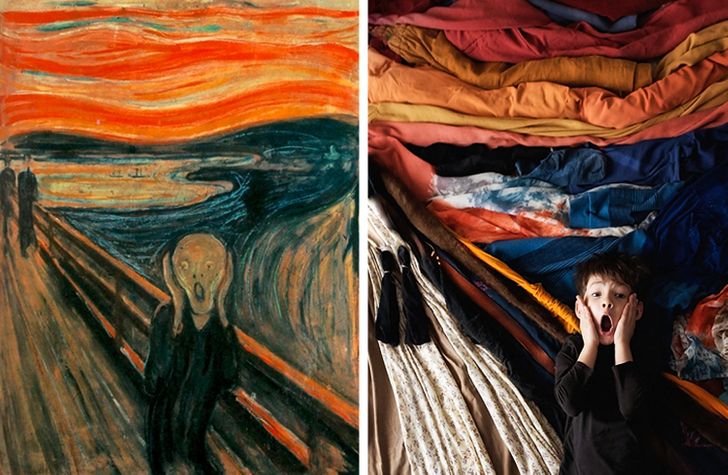Movie art
Few great cinematographers have had longer careers than Conrad Hall, who, in 1970, won an Oscar for Butch Cassidy and the Sundance Kid (1969),and decades later nabbed two more, for American Beauty (1999) and Road to Perdition (2002) richpalm. Throughout those decades, he’d consult the creations of many notable painters, but none more frequently than Edward Hopper. Hopper modeled several of his paintings off of scenes from movies; it’s only fair that, in his own work, Hall returned the favor.
This 1986 classic provides quite a different museum scene. During their self-inaugurated day off, Ferris, Cameron and Sloane head to the Art Institute of Chicago. Across a few shots, the museum’s extensive collection is seen on screen. Soon, the characters themselves become art-like, posing in perfect alignment with the rules of perspective.
Despite the nature of its existence, the artwork nevertheless plays a crucial role in the film. It begs the question: what does it mean when art is created for cinematic purposes? Julian Schnabel’s Basquiat is a famous example of this. Unable to show the works themselves due to copyright issues, Schnabel had to recreate Basquiat-inspired paintings for the film.
Classic artwork
To embark on this quest, we delve into the rich tapestry of art history, commencing with the transformative era of the Italian Renaissance in the 15th century. This period marked a profound shift in the trajectory of Western art, emphasizing naturalism, human ideals, and a departure from exclusively religious themes. Our curated list of 100 iconic paintings spans from the culmination of the 15th century to the first half of the 1900s, capturing the essence of timeless classics that have transcended epochs.

To embark on this quest, we delve into the rich tapestry of art history, commencing with the transformative era of the Italian Renaissance in the 15th century. This period marked a profound shift in the trajectory of Western art, emphasizing naturalism, human ideals, and a departure from exclusively religious themes. Our curated list of 100 iconic paintings spans from the culmination of the 15th century to the first half of the 1900s, capturing the essence of timeless classics that have transcended epochs.
Today, there are numerous ways to furnish and reinvigorate your home or workplace. Whether you’re contemplating a redesign of your walls, considering new furniture, prints, posters, mirrors, plants, or artwork, the possibilities for beautifying these spaces are limitless. If you’re considering a makeover for a room in your home or office, why not let BrushWiz create a painting for you? We specialize in hand-painted reproductions of famous paintings, as well as lesser-known artworks. Are you a fan of Monet or Da Vinci? Have you always dreamt of owning Van Gogh’s ‘Starry Night’? Whatever your taste in art, forget about opting for cheap, low-quality prints, and consider ordering a hand-painted fine art reproduction from us today!
Johannes Vermeer’s 1665 study of a young woman is startlingly real and startlingly modern, almost as if it were a photograph. This gets into the debate over whether or not Vermeer employed a pre-photographic device called a camera obscura to create the image. Leaving that aside, the sitter is unknown, though it’s been speculated that she might have been Vermeer’s maid. He portrays her looking over her shoulder, locking her eyes with the viewer as if attempting to establish an intimate connection across the centuries. Technically speaking, Girl isn’t a portrait, but rather an example of the Dutch genre called a tronie—a headshot meant more as still life of facial features than as an attempt to capture a likeness.
The Arnolfini Portrait encapsulates how oil paint permitted unprecedented descriptiveness that ignited enduring discussions of subjects’ hidden motives and the role of the artist versus beholder. As an early masterpiece in naturalism, it signals Northern Europe’s rival achievements during the Italian Renaissance.
The debates it stirred – who looks, at what, and why – cascade through modern discussions on pornography versus erotica and the politics of private pleasure and aesthetics. Identity unknown, its first owner called it “the origin of the world” – an ironic wink to hidden wells of being.
Collectible graphic
Welcome to the Graphic Collectibles’ online gallery of original, collectible comic artwork. From original Superman comic art and Spider-Man comic art, to original X-Men comic art and Batman comic art, Graphic Collectibles carries it all. The owner, Mitch Itkowitz, has been in the business of selling original/vintage comic art for over 40 years.
Virtual spaces like Decentraland, The Sandbox, and Roblox are creating digital collectibles that can be displayed, traded, and used inside metaverse ecosystems. Limited-edition virtual real estate, wearables, and avatars are fetching massive prices.
🔹 Follow the latest trends – Stay ahead of market shifts & new investment opportunities.🔹 Showcase your collection – Build a personalized digital collection profile.🔹 Trade & connect with other collectors – Buy, sell, and swap securely.🔹 Get market insights – Track real-time valuations and auction results.
Whether you are a seasoned comic book art collector or just beginning to collect, Graphic Collectibles offers the most diverse selection of comic art to satisfy everyone’s tastes! We receive new original artwork on a regular basis, and notify our clients on our mailing list first. We look forward to hearing from you.
Theatrical artwork
In zijn meest recente werk geeft Andrew het beeld pas echt de ruimte. Er spreekt een grote vrijheid uit het gebruik van kleur en compositie, die als vanzelfsprekend deel uitmaken van het vlak van het schilderij. Figuren maken zich los van de achtergrond en verdwijnen weer.
The pictorial motifs contained in the paintings at the Theatermuseum refer to the world of the theatre. Around six hundred portraits, character and scene pictures done in various techniques bear witness to the fascination that theatre has exercised over such visual artists as Alfred Hrdlicka and Anton Kolig.In contrast to the collection of hand sketches, which contains primarily stage and costume designs, only a few of these pictures were conceived as part of a specific theatre production. The lion’s share serves first and foremost to commemorate famous artistic personalities and their roles.
The 19th century introduced realism as a dominant theatrical style, challenging traditional conventions. In the 20th century, experimental and avant-garde movements emerged, pushing the boundaries of conventional theater.
It was painted by the Venetian master Marco Ricci around 1709, and captures a rehearsal for the opera Pyrrhus and Demetrius. Among those depicted are the castrato star, Nicolò Grimaldi (usually known by his stage name ‘Nicolini’), pausing grandly in front of a harpsichord, and the celebrated soprano Francesca Margherita de L’Epine, seated behind the instrument.
Everyone can recognize the look of the theater stage. The lighting is dynamic with sharp contrast, the figures are starkly illuminated, and almost everything is exaggerated in some way, whether in costume or in gesture or both. The theatre carries a wonderful notion of story-telling and imagination with it that creates a framework for imagination. The dark curtains and raised platforms of the stage create the illusion that scenes that play before the viewer are in fact real, and that the audience is merely intruding on a story that would have happened regardless of whether or not they were listening in. This, to me, is the essence of the stage. In a sense, nearly all artistic arrangements of figures within a piece draw from the same principles that make up the ways in which a director would position actors within a scene. Paintings of interactions between people can be created to have an almost cinematic feel, drawing from that same notion that what is happening within the image would happen by itself, regardless of whether or not the viewer was there to see it. These images aren’t static; the events depicted are motion-oriented, and the viewer is almost always left wondering what might happen next within the scene. These works in particular create their own “stages”, where some of the details of the locale are shrouded through tenebrism or infinite space, placing more importance on the figures and their implied actions. This gallery is a collection of Renaissance and Baroque paintings that depict events happening within their own stages, alluding to the idea of being in theater.





